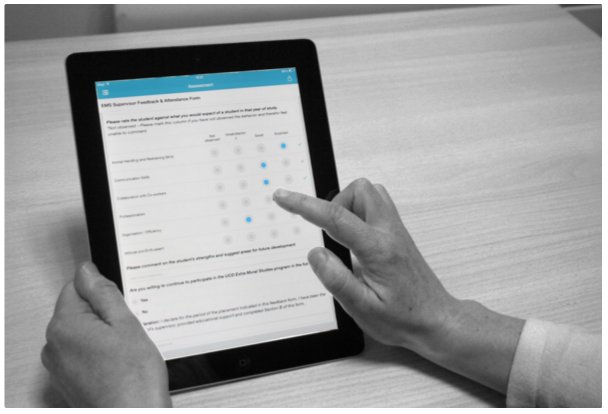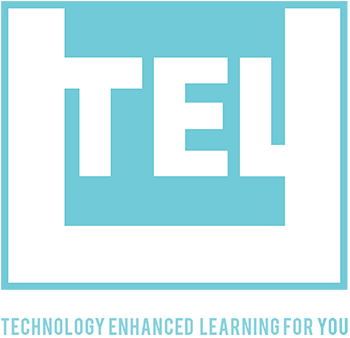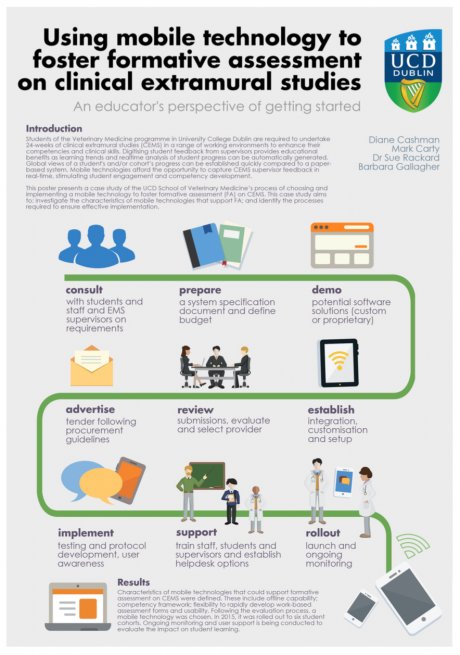Who are you and where do you teach?
My name is Barbara Gallagher; I am a clinician, a lecturer and researcher in the School of Veterinary Medicine, University College Dublin. My clinical background is in veterinary small animal internal medicine. I teach undergraduate veterinary students in their pre-clinical years, usually via lectures and tutorials and I teach undergraduate veterinary students on clinical rotations, usually by demonstrating clinical examination techniques and examining their investigative process surrounding referred clinical cases; this group also participates in small group teaching.
I am the module coordinator for two modules: Veterinary Endocrine, Metabolic and Dermatology and Clinical Extra Mural Studies (CEMS). This case study discusses my use of mobile technology in my CEMS module to deploy and mange workplace-based assessments (WBA).
What technology do you use for teaching and learning?
Veterinary medicine students complete 24 weeks of seeing veterinary practice during their 3 rd , 4 th and 5 th year of study. The completion of this work results in the award of a 40ECTS credit CEMS module.
To assess students on CEMS placements, I use a mobile app that has the capacity to record the student’s progress. I have designed a range of WBA forms that students must complete with their CEMS supervisors at the end of their placement. These forms allow the student to provide details of the placement they are currently on, for their supervisor to provide feedback and to verify the student’s attendance on placement in their practice.
The WBA forms were digitised and deployed to students through the mobile app, which can be accessed on the student’s mobile device. Once the student has completed the WBA form with their supervisor, the completed WBA form uploads to a central database that allows me to monitor their learning and progress over the three-year period.

What appealed to you about using this technology for your teaching practice?
As students can see a variety of veterinary practices while on CEMS the technology allows me to rapidly create a range of WBA forms that can be generated to meet the specific needs of a placement type (e.g. research placements vs. clinical placements). This is a key advantage of the technology as it gives me full flexibility to design WBA forms to meet the specific educational requirements of my module.
The WBA forms facilitates the assessment of a student across several different competencies (professionalism, knowledge, practical skills etc.) on a likert scale (unacceptable, fair, good, excellent). I can include other question types on the WBA forms such as multiple-choice that allows the student’s supervisor to provide an overall global assessment of the student. I can also include a free text section, which the supervisor can input additional feedback to expand upon the student’s performance if necessary.
The WBA forms are easy to complete and the mobile app is ease to use, therefore the schedule of the student’s supervisor, who is typically in a busy work environment, is minimally disrupted.
The technology is suitable for use when the device is offline. Once a form has been completed it is locked down and can be submitted at a later date once Internet access is available. This is very convenient for veterinary students as they may be completing forms in rural areas with no 4G or wifi connectivity, similarly it can be troublesome to access the Internet in the clinical environment due to network security restrictions.
Finally, the technology allows the student, their supervisor and the module coordinator to obtain and retain a copy of each WBA assessment in a timely fashion. This enables the student reflect on the feedback they have received and provides progression data that can be interrogated by their UCD tutor.
How do you use this technology with students?
I use it to streamline the assessment process of my CEMS module. CEMS is usually a clinical experience that takes place outside the university setting, in Ireland or any part of the world. The technology is therefore advantageous as students can submit WBA forms from any location just after their placement and they don’t have to wait to return to UCD to hand in a paper copy. There are educational benefits to this approach as I can monitor student’s learning and progress during the summer when most of the CEMS placements take place, and I can offer support in a timely fashion if required by a student. Having access to this technology offers the School of veterinary medicine an opportunity for WBA forms to be digitally centralised. This allows students to develop a portfolio of their individual assessments that can be used to promote self-regulated learning; students can reflect on their overall performance and set goals for future learning after reviewing their portfolio.
What do you think are the main benefits and main drawbacks to using this technology?
The benefits are that this technology has replaced a paper-based assessment form, which was more subjective and had a greater capacity to be plagiarised. It also ensures that both the university and the student have an up-to- date record of all students WBAs.
To date drawbacks are minimal, they usually surround errors in completing a form accurately rather than using the technology.
What advice would you have for someone looking to use this technology with students?
It is important that the technology has the capacity to meet the needs of the students and the supervisor who is assessing them. It must be secure and have the facility to be backed up. It must be user-friendly. It must be introduced in a suitable manner, to allay fears or concerns. Local backup services must be available to troubleshoot and provide ongoing user support. It should have the capacity to be further developed to meet ongoing needs and ideally, have the capacity to be utilised in more than one educational setting.



1 comment